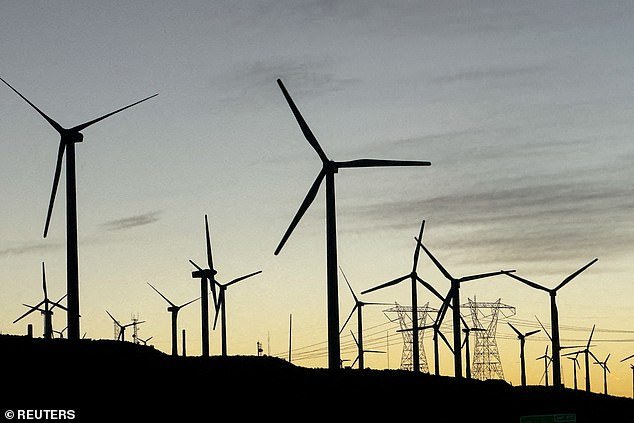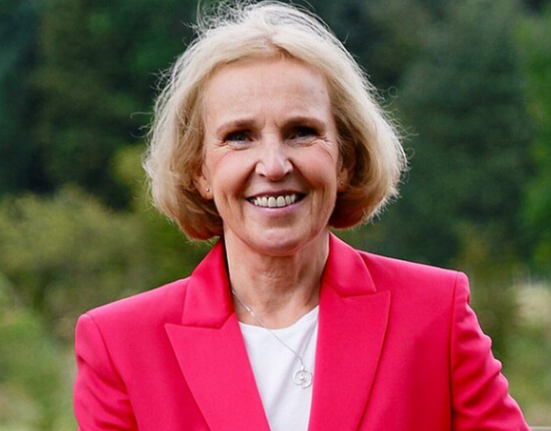Renewable infrastructure trusts might have suffered of late, but that means some are offering bumper double-digit dividend yields.
Is this an opportunity and could the future still be looking bright over the long term?
In this column, William Heathcoat Amory, managing partner at Kepler Partners, says renewable infrastructure trusts could be a bargain if you know where to look.
Renewable infrastructure trusts have taken a beating in recent years. The main reason for this is not hard to discern: a whopping circa 5 per cent increase in interest rates since 2022.
This means that there are now a lot of interesting investments available to income investors that were not as high yielding previously.

Dividend opportunity: Renewable energy infrastructure assets typically have long economic lives, with low operating costs
Renewable infrastructure trusts use considerable amounts of leverage (mostly fixed rate), and so the prospect of a significant increase in the cost of borrowing when it needs to be refinanced, poses a longer-term challenge for the asset class, and has spooked some investors.
Those with short term borrowings are paying higher interest rates, and will be actively trying to sell assets to pay back these borrowings. The subdued sentiment means there are potential bargains to be found.
The rise and fall of renewable energy trusts
Fundamentally, renewables offer a high income, uncorrelated to equity markets and the economic cycle, with links to inflation.
This meant that in the previous low-interest rate environment, they were on every income investor’s shopping list. Most trusts traded at significant share price premiums to net asset value (NAV), and trusts issued shares regularly to meet demand.
The sector mushroomed in size as a result. Nothing lasts forever though, and the current discounts to NAV are reflective of an inevitable readjustment, so that supply and demand for the shares of these trusts once again match.
As the graph below shows, this process has already started with buybacks widespread, albeit relatively slowly.
Consolidation is underway, with some trusts’ shareholders having elected to realise assets over time and wind up. Others have the scale and quality that means they are likely to survive.

Consolidation is underway, with some trusts’ shareholders having elected to realise assets over time and wind up
Why renewables trusts are trading at a discount
In contrast to traditional investment trusts which, when faced with a wide share price discount to NAV, have liquid underlying holdings which can be sold and the proceeds being used to buy shares back or return capital to shareholders, renewables trusts invest in hard assets – wind or solar farms.
As one might imagine, these are illiquid. Much like selling a house, sales can be achieved but take time – especially if one wants the best price.
This perhaps explains why discounts have persisted so long. Trusts are buying shares back, but perhaps not yet at a rate that has properly addressed the supply and demand imbalance.
According to a recent presentation on TRIG, InfraRed Capital Partners (the company’s managers) said that, despite the market softening over the past six months, there is still a good level of interest in renewables assets, with private market investors paying prices that reflect current NAVs.
For TRIG, since 2022 the team have sold 10 per cent of the portfolio, (or £210million of assets) at prices which reflected a premium to NAV at the time of sale.
This suggests that valuations that make up NAVs are fair, although clearly this is an opaque market and much can change.
| Trust | Total assets (£m) | Discount to NAV % | Dividend yield % |
|---|---|---|---|
| Aquila European Renewables | 513 | -23.5 | 8.0 |
| Bluefield Solar | 1,300 | -24.4 | 9.6 |
| Downing Renewables & Infrastructure | 300 | -28.6 | 7.2 |
| Foresight Environmental Infrastructure | 846 | -30.9 | 10.4 |
| Gore Street Energy Storage | 813 | -36.4 | 10.8 |
| Greencoat UK Wind | 4,420 | -24.0 | 9.1 |
| NextEnergy Solar | 1,079 | -30.4 | 12.9 |
| Octopus Renewables Infrastructure | 1,064 | -30.7 | 8.8 |
| Renewables Infrastructure Group (TRIG) | 3,122 | -29.8 | 9.2 |
| SDCL Efficiency Income | 1,095 | -52.0 | 14.4 |
| VH Global Energy Infrastructure | 412 | -35.3 | 8.6 |
| Source: AIC, all data as at 30/05/2025 | |||
Big dividends are on offer – are they backed up?
The current discounts to NAV mean that for investors today, dividend yields are significantly higher than the yields that private market investors would expect.
So what then are the prospects for investors in these trusts?
As we highlight above, private market investors appear relatively sanguine on valuations. The discounts to NAV might reflect caution on gearing, which most trusts employ at a meaningful level.
By and large, trusts either have fixed structural gearing on an asset specific basis, which is being paid down over time. Or they have trust level gearing, which will either need refinancing at a point in the future or repaid.

William Heathcoat Amory, of Kepler Partners
Whichever way gearing is employed, owning assets that deliver high levels of cashflow, debt levels appear manageable over the short to medium term.
Underpinning dividends are the cashflows that arise from inflation-linked subsidies and the proceeds from electricity sales. In some parts of the world, particularly the US, future subsidy regimes appear to be being unpicked.
In the UK, we are in one of the foremost locations for wind power, and this – together with what Bill Gates called ‘clever government subsidies that encouraged companies to invest’ (in his book ‘How to avoid a climate disaster’) – is the reason why the UK has achieved a significant shift away from fossil fuel energy.
According to data from a great open-source National Grid website Iamkate, the UK’s electricity supply has gone from 68.7 per cent fossil fuel based in 2012 to only 28.2 per cent in 2024.
What’s on offer for UK investors?
For denizens of the UK, it is often missed that we are at the forefront amongst countries in the energy transition.
In particular, the UK is a significant leader in offshore wind, with installed capacity of offshore wind turbines far greater than the US in absolute terms, not just in proportion of the energy mix.
In Gates’ view, offshore wind power is one of the most promising technologies that needs to be better harnessed around the world to achieve a significant reduction in carbon emissions.
As one might expect, within the renewable energy trusts, offshore wind represents a reasonable proportion of exposure.
Greencoat UK Wind for example has 45 per cent of its portfolio in offshore wind farms, which offer high investment returns and is one of the reasons the trust has been the best performer in NAV total return terms in the peer group over the last three and five years.
In early May this year, Ørsted announced that it had decided to discontinue its Hornsea 4 project in the UK in its current form due to the numbers not adding up in terms of investment return.
This would have become one of the biggest offshore wind farms in the world, and so its cancellation or delay represents a blow to government and the UK’s ambitions for decarbonisation and energy security.
For shareholders in existing renewable assets, it’s possible that this is a positive, in that there will be less generating capacity built out, and therefore higher long term electricity prices than would otherwise be the case.
For wind farms owned by the likes of TRIG and Greencoat UK Wind, a rough rule of thumb is that around half of wind revenues come from subsidies, and half come from the proceeds of electricity sales.
According to Iamkate, wholesale electricity prices have been relatively resilient over the past 12 months, at £82 per MWh, meaning that both trusts have been paying a covered dividend, and still repaying debt or re-investing in share buybacks or new assets.
Both have demonstrated resilience in terms of dividend cover through difficult periods like 2020, when electricity prices fell dramatically during the COVID-19 crisis.
The main attraction today is the high initial dividend yield, which as the table above suggests, many offer a multiple of the yield of the FTSE 100 (which yields 3.5 per cent at the time of writing).
Verdict: An interesting moment for defensive income
Renewables trusts offer a level of defensiveness to investors, not least because demand for energy is not likely to subside substantially.
The price of energy is hard to predict and can fluctuate, but there are comparatively low levels of volatility in renewable infrastructure’s cash flows.
Renewable energy infrastructure assets typically have long economic lives, with low operating costs (especially compared to hydrocarbons) and over time generate a fairly predictable amount of energy.
This makes forecasting cashflows simpler than it would be compared to many other asset classes. In addition, subsidies for renewables have a direct link to inflation. This means that if inflation remains persistent, renewable energy cashflows should increase.
The result is that the income that renewable energy infrastructure assets produce can be resilient, and sometimes offer built-in upside sensitivity to inflation and energy prices.
Investor sentiment towards renewables is not strong for perfectly good reasons, mainly because of higher interest rates, but exacerbated by political noises coming from America. But there are two fundamental reasons why the future for renewables in the UK and Europe remains bright.
Firstly, de-carbonisation needs to happen, to reduce the harmful effects on climate change of future (and past) emissions of carbon dioxide.
Secondly, energy security is increasingly important. In a world where old alliances seem to count for nothing, no government wants to find themselves in a position where they have to rely on an allegiance which may no-longer exist.
Both of these themes provide a supportive backdrop for a long-term investment in renewable energy infrastructure. Across the renewables infrastructure sector, there are trusts exposed to different types of renewable technology and portfolios have different degrees of quality.
As such it will pay to do a little research, and establish which have the highest quality portfolios but whose share prices have been dragged down unfairly with the peer group.
With discounts wide but dividend yields remaining resilient, this may be an interesting moment to add some defensive income to a portfolio.
DIY INVESTING PLATFORMS

AJ Bell

AJ Bell
Easy investing and ready-made portfolios

Hargreaves Lansdown

Hargreaves Lansdown
Free fund dealing and investment ideas

interactive investor

interactive investor
Flat-fee investing from £4.99 per month

InvestEngine

InvestEngine
Account and trading fee-free ETF investing
Trading 212
Trading 212
Free share dealing and no account fee
Affiliate links: If you take out a product This is Money may earn a commission. These deals are chosen by our editorial team, as we think they are worth highlighting. This does not affect our editorial independence.







